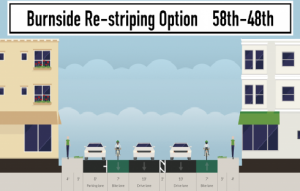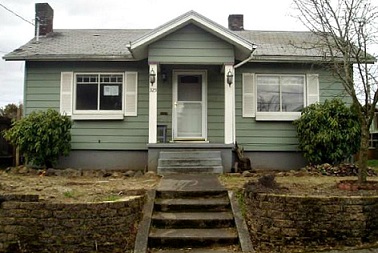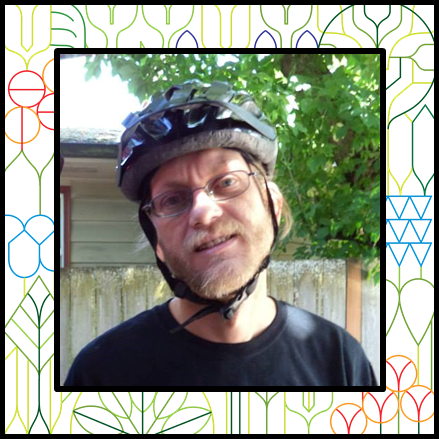 A passionate and knowledgeable activist, Terry Dublinski-Milton is bringing innovative and eco-friendly ideas to his position as Land-Use and Transportation Chair for the North Tabor Neighborhood Association. Elected in late 2013, Terry has been mobilizing neighbors and neighborhood associations to support safety modernization for East Burnside, including adding high-quality bike lanes. We sat down with Terry to discuss his ideas and experiences thus far in his tenure.
A passionate and knowledgeable activist, Terry Dublinski-Milton is bringing innovative and eco-friendly ideas to his position as Land-Use and Transportation Chair for the North Tabor Neighborhood Association. Elected in late 2013, Terry has been mobilizing neighbors and neighborhood associations to support safety modernization for East Burnside, including adding high-quality bike lanes. We sat down with Terry to discuss his ideas and experiences thus far in his tenure.
Joining the North Tabor Neighborhood Association was not your first foray into advocacy. You’ve been actively involved in advocacy efforts in Portland for years, particularly those focused on transportation. Can you tell me a little about your past work?
I moved to Portland in ’98 after I did my undergraduate work at University of Wisconsin – Madison and got attached to the Urban Studies Department at Portland State. I completed about a year of courses in the Urban Studies masters program. During this time, we analyzed the Hawthorne Streetscape and I also studied the South Waterfront plan as it developed.
I was drawn to work on active transportation because not only is it about safety, but also climate-change mitigation and health. Our society is heavy in carbon and obese and we need to fix both of those or they are going to cripple civilization in the long term.
I began with letter writing for various projects and then I went to public outreach meetings for the North Portland Greenway, among others. I tried to form my own movement – Coping with Bikes – which would help create an integrated ½ mile grid network of residential Greenways connecting the entire area between the river and I-205. It was a great idea, low-cost with high benefits but it didn’t take off. So instead I teamed up with Beth Sanders and we started to rebuild the North Tabor Neighborhood Association. I figured this would be a good way to integrate my ideas – with a few cost effective fixes our neighborhood could have a robust active transportation network.
What have you found to be the advantages and disadvantages of working with transportation and land use issues through the neighborhood system versus outside of it?
We have a lot of different advocacy groups outside the system, and at the same time Portlanders are kind of burned out on advocacy. Volunteers are over-extended and trying to get them to join a new group, when there are already so many out there, is very difficult.
There’s always some tension when you have a new idea, whether you want to work inside or outside the system. Working inside the system, I’ve begun to notice changes, like what Laurelhurst did; they extended their road diet on Burnside. When you’re working from inside the system you can transmit ideas readily within the established structure, which a lot of the time helps get the word out efficiently, but at the same time we’re working inside this big transportation bureaucracy that takes a long time to do anything. Sometimes you have to balance the two and it can get frustrating.
You’ve been quite active in looking for ways to make East Burnside safer for all users. What strategies have you used to engage residents, businesses, and city staff in this conversation and mobilize support? Which were the most effective, and why?
 So far the most effective approach was using the High Crash Corridor Program and forming a group called CURBS (Citizens United Rebuilding Burnside Safely) to access city staff and resources. As far as engaging residents, we’ve gone through the neighborhood association.
So far the most effective approach was using the High Crash Corridor Program and forming a group called CURBS (Citizens United Rebuilding Burnside Safely) to access city staff and resources. As far as engaging residents, we’ve gone through the neighborhood association.
One of the ways I’ve engaged is meeting with an engineer at PBOT (Portland Bureau of Transportation) and talking to the pavement people – it’s time for a grind down and repaving of Burnside. They said if we can come up with a new lane configuration for the stretch between 47th and 60th, they hopefully will be able to implement it. So I’ve worked with the Neighborhood Associations and the businesses to get the word out. I’ve also gone door to door on several blocks and multiple businesses. The outreach efforts will increase this fall because East Burnside is scheduled to have sewer pipe repairs next year. After the sewer line, assuming everything lines up right, Burnside would have to be repaved, which increases the opportunity for the changes we are advocating for.
Since a road reconfiguration would require some parking removal, I’ve gathered data on the demand for parking. I’ve done about twenty car counts at odd times of the day, riding up and down the street and counting the cars and where they’re parked. And I’ve figured out exactly where the in-demand spots are and a way to save most of them.
You recently worked with neighbors and a developer to organize an event where people could salvage materials from a house before it was demolished. How did it go, what did you learn from the experience, and would you encourage others to try this?
 This was a small house and we had a very short timeline, but we managed to salvage a significant amount of things. What did I learn? – That you need more lead time. We didn’t have enough time to organize. We needed a series of volunteers to come in and dismantle. There were beams, sheathing, molding, and old rough wood – stuff that if we had had a team of 6 to 8 people, could have been dismantled in the 4 days we planned for. But luckily we were able to get the time extended. The developer was very flexible.
This was a small house and we had a very short timeline, but we managed to salvage a significant amount of things. What did I learn? – That you need more lead time. We didn’t have enough time to organize. We needed a series of volunteers to come in and dismantle. There were beams, sheathing, molding, and old rough wood – stuff that if we had had a team of 6 to 8 people, could have been dismantled in the 4 days we planned for. But luckily we were able to get the time extended. The developer was very flexible.
I’d encourage any neighborhood that has a house that is small and decrepit, where saving the house is not worth it, to try this and work with the developers. We were able to salvage appliances, light fixtures, a neighborhood coffee shop got an old floor, siding, sheathing; all sorts of odd stuff, things that would’ve normally been thrown in the landfill. We didn’t take the structure apart. Windows, doors, that sort of thing was saved, which is better than nothing!
But at the same time what I would like to see is an organized effort to dismantle these houses and use the raw materials to build tiny houses or something. There were so many opportunities at this last house that just went away with the bulldozers because we didn’t have the time, man power or organization.
The North Tabor Neighborhood Association is interested in increasing density, maintaining historic housing stock, and providing more affordable housing. Recent experience has shown that doing all three in the same neighborhood can be extraordinarily challenging. What ideas do you have to address all three of these interests?
I would like to see a multiple tiered system for demolitions, where if you are a developer and you come in and have an old house and you say, “I just want to dig it up!” and bulldoze away, the permit is really expensive. Next would be a permit which is not quite as expensive, for the developer who saves, dismantles and donates. The cheapest permit would be if the developer saves at least 50% of the structure and adds onto it. At the same time, we should change some of the design standards to allow for duplexes, conversions, and more flexible ADUs in lower-density single-family neighborhood. We also need inclusionary zoning for larger building projects so we can include low income units.
European cities have done this for centuries. They save their existing structures and build onto them. We do not have to have disposable housing, which is what we’re doing right now. Carbon emissions take something like 60 years to recoup when you tear down and rebuild. We could save a lot of that carbon if we just remodeled and added on. It would also allow us to retain neighborhood character, stem demolitions, and get more density to absorb the up to 400,000 people estimated to be moving here in the next 20 years.
